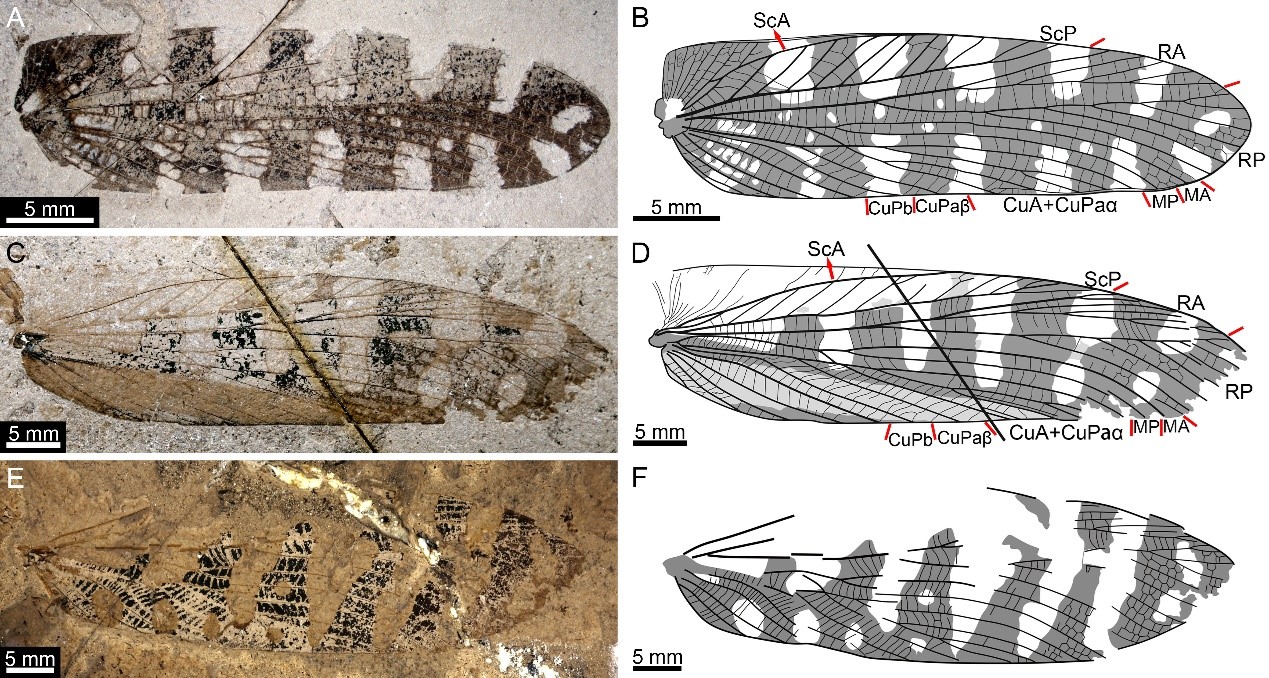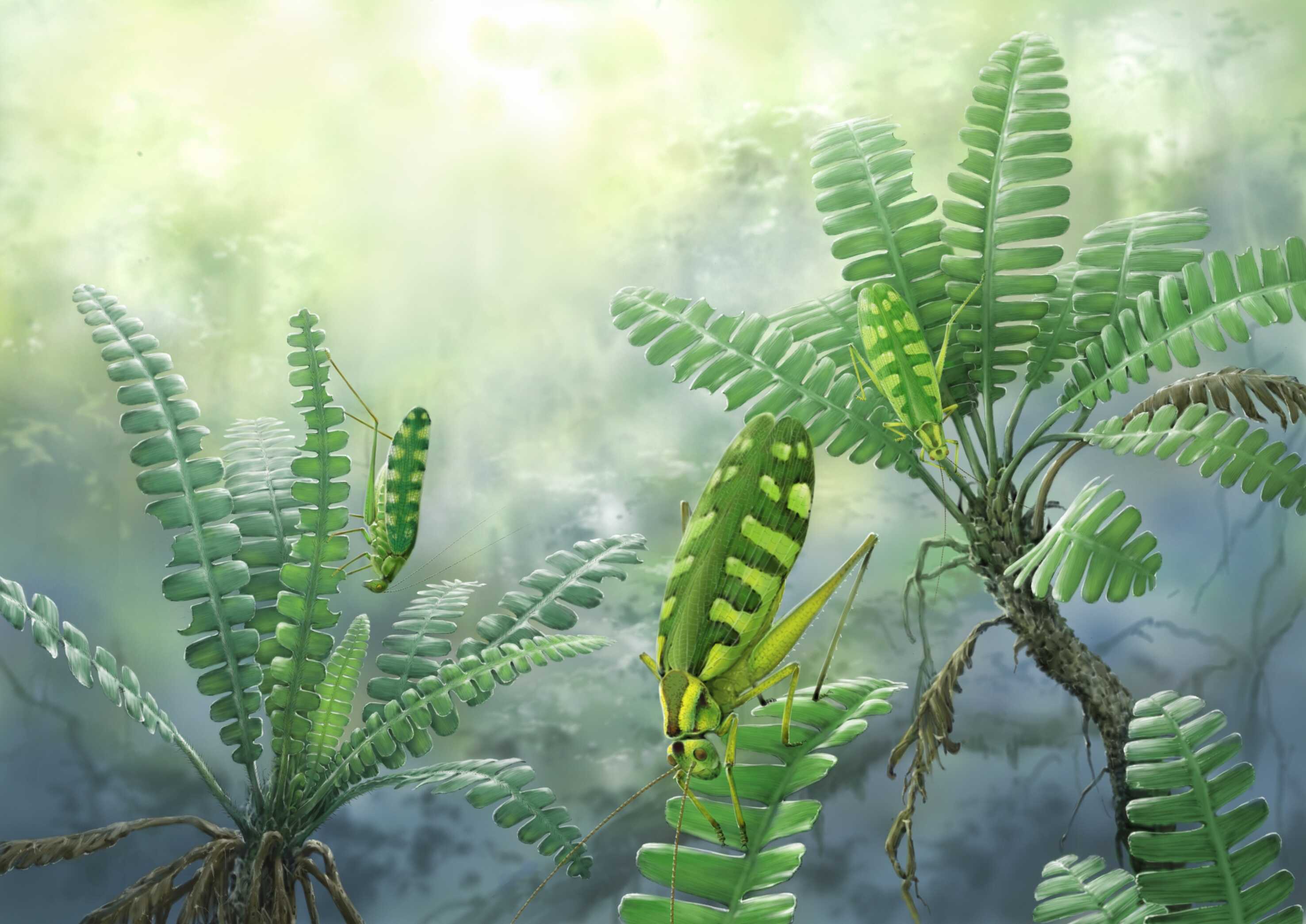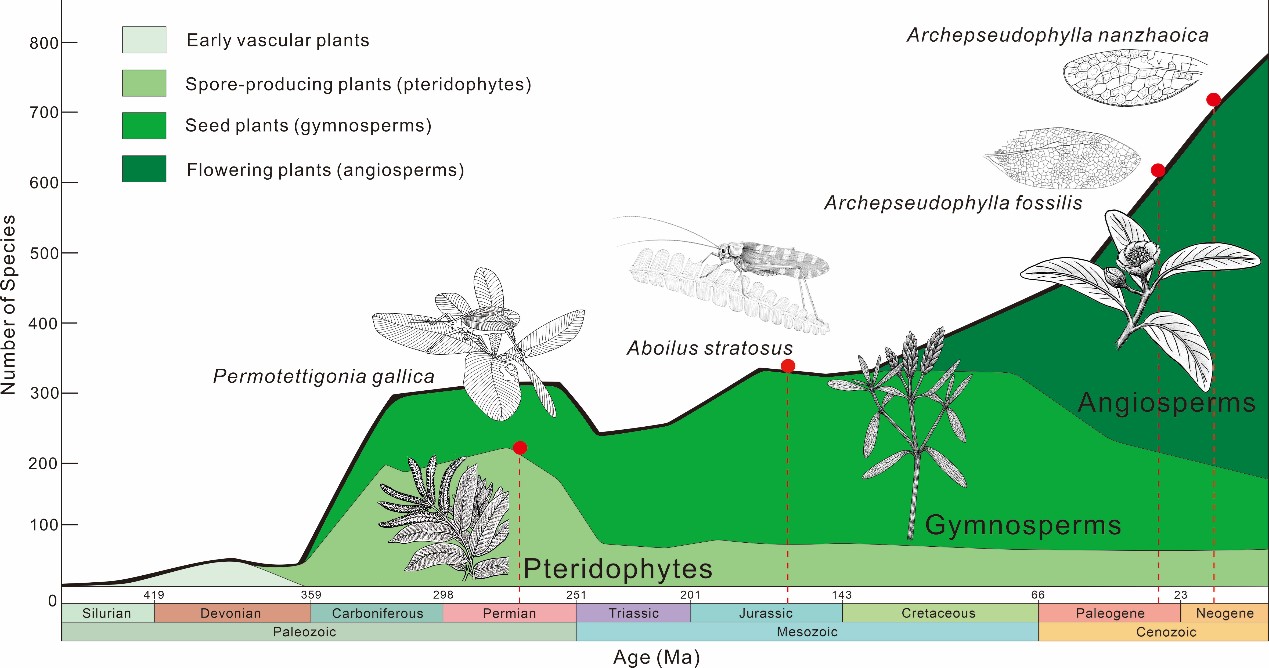A research group led by Prof. HUANG Diying from Nanjing Institute of Geology and Palaeontology, Chinese Academy of Sciences (NIGPAS), reports three Jurassic orthopterans (grasshoppers and crickets, including katydids) (Prophalangopsidae: Aboilinae) from the Daohugou Biota (ca. 165 million years ago, Inner Mongolia, NE China) with forewing patterns strikingly similar to the bennettitalean (extinct seed-bearing, cycad-like group) leaves.
This represents the first unambiguous evidence in which both the mimicking insects and their plant models are preserved in the same bedding plane. The study was published online in Geology on August 28, 2025.
The studied fossils reveal two distinct mimicry types. In Aboilus stratosus, the forewings bear six to seven transverse rectangular bands and are bisected by a longitudinal stripe running from the base to the tip, resembling the distal portion of Anomozamites fronds (figure 3A). In Sigmaboilus sp., the forewing features an inclined, nearly longitudinal stripe running across the wing, connecting six transverse rectangular bands, resembling one lateral side of an Anomozamites frond, as if medially divided along the rachis to produce a symmetrical half frond (figure 3B). In the resting position, the paired forewings would form a complete frond with leaflets along a central rachis.
Bennettitales were a major component of Mesozoic floras before the rise of the flowering plants. Leaves of Anomozamites were widely distributed across Laurasia from the Late Triassic to the Early Cretaceous and constituted a dominant element of the Daohugou flora. According to the statistics, both Aboilinae and Anomozamites exhibit a broadly similar trend in species richness, peaking in the Middle Jurassic and declining in the Early Cretaceous, suggesting potential ecological associations. Additionally, Aboilus and Sigmaboilus are representatives of large herbivorous insects in the Daohugou biota, and some Anomozamites leaves from the same beds exhibit shallow to deep scalloped incisions along the leaflet margins interpreted as evidence of herbivory damage. We infer that these Jurassic leaf-mimicking insects inhabited and fed on Anomozamites, and that this sustained ecological association may have provided a functional context for the evolution of leaf mimicry.
The study further suggests that increasing predation pressure in the Jurassic may have driven the evolution of leaf mimicry. Although stem birds were rare during the Jurassic, the Daohugou biota hosted a diverse assemblage of potential predators capable of preying on prophalangopsids, including the gliding insectivorous Volaticotherium, the arboreal dinosaurs Epidendrosaurus and Epidexipteryx, and the insectivorous anurognathid pterosaurs Jeholopterus. In the Cenozoic, katydids evolved more elaborate mimicry forms, including dead leaf analogues and mimics of partially eaten leaves. This increasing specialization likely reflects intensified predation pressure, associated with the emergence and rapid diversification of modern avian lineages after the Late Cretaceous and the subsequent radiation of passerine birds during the Paleogene–Neogene transition.
Orthopterans are among the most common herbivorous insects. Fossil evidence shows that their mimicry strategies have responded to the evolutionary turnover of dominant plant groups, from spore-bearing plants and gymnosperms during the Paleozoic and Mesozoic to angiosperms during the Cenozoic (figure 5). This finding highlights the dynamic interplay between plant community succession, predation pressures, and insect defensive strategies, expanding our understanding of the ecological significance and evolution of leaf mimicry in orthopterans.
This work was supported by the National Key Research and Development Program of China, the National Natural Science Foundation of China, the Jiangsu Funding Program for Excellent Postdoctoral Talent, and the Volkswagen Foundation. The research team included collaborators from Nanjing Institute of Geology and Palaeontology (NIGPAS) and Ludwig-Maximilians-Universität München (LMU Munich), with artwork by Sun Jie.
Reference: Fu Y, Dong C, Fabrikant D, Cai C, Haug C, Haug J, Huang D. 2025. Unique leaf mimicry in Jurassic insects. Geology. https://doi.org/10.1130/G53399.1.

Fi.1 Leaf-mimicking orthopteran fossils of Prophalangopsidae from the Daohugou biota

Fig.2 Fossil leaves of Anomozamites

Fig.3 Reconstructions of two prophalangopsid species exhibiting distinct types of mimicry on Anomozamites leaves.

Fig.4 Paleoart illustration showing the two species’ leaf mimicry among Anomozamites in the Daohugou biota

Fig.5 The relationship between orthopteran leaf mimicry and the dominant plant groups throughout different geological periods
Download:
